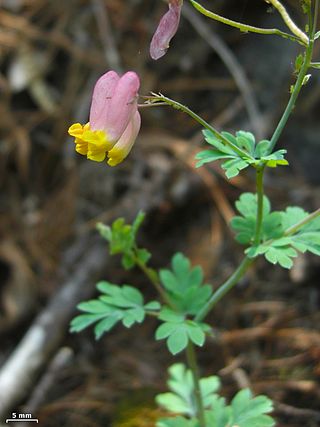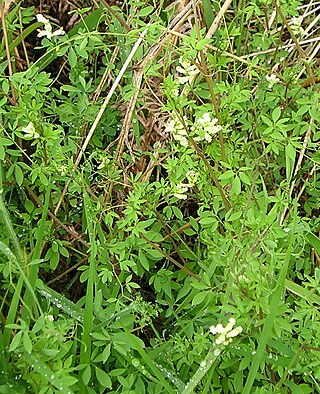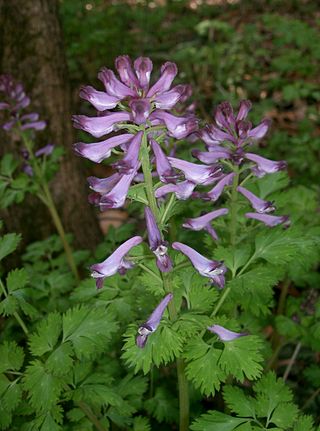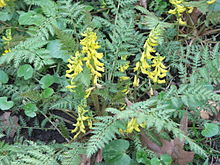
The Papaveraceae, informally known as the poppy family, are an economically important family of about 42 genera and approximately 775 known species of flowering plants in the order Ranunculales. The family is cosmopolitan, occurring in temperate and subtropical climates like Eastern Asia as well as California in North America. It is almost unknown in the tropics. Most are herbaceous plants, but a few are shrubs and small trees. The family currently includes two groups that have been considered to be separate families: Fumariaceae and Pteridophyllaceae. Papaver is the classical name for poppy in Latin.

Corydalis is a genus of about 540 species of annual and perennial herbaceous plants in the family Papaveraceae, native to the temperate Northern Hemisphere and the high mountains of tropical eastern Africa. They are most diverse in China and the Himalayas, with at least 357 species in China.

Sanguinaria canadensis, bloodroot, is a perennial, herbaceous flowering plant native to eastern North America. It is the only species in the genus Sanguinaria, included in the poppy family Papaveraceae, and is most closely related to Eomecon of eastern Asia.

Genista monspessulana, commonly known as French broom, Montpellier broom, or Cape broom (Australia), is a woody leguminous perennial shrub. The yellow-flowering bush is native to the Mediterranean region, and while it may still be commonly sold in some garden stores, it is considered an invasive plant in most places where it has been introduced. It is a noxious weed on the western coast of the US and in parts of Australia.

Trifolium campestre, commonly known as hop trefoil, field clover and low hop clover, is a species of flowering plant native to Europe and western Asia, growing in dry, sandy grassland habitats, fields, woodland margins, roadsides, wastelands and cultivated land. The species name campestre means "of the fields".

Stylophorum diphyllum, commonly called the celandine poppy or wood poppy, is an herbaceous plant in the poppy family (Papaveraceae). It is native to North America, where it is found in the eastern United States and Ontario. Its typical natural habitat is moist forests over calcareous rock, particularly in ravines.

Elaiosomes are fleshy structures that are attached to the seeds of many plant species. The elaiosome is rich in lipids and proteins, and may be variously shaped. Many plants have elaiosomes that attract ants, which take the seed to their nest and feed the elaiosome to their larvae. After the larvae have consumed the elaiosome, the ants take the seed to their waste disposal area, which is rich in nutrients from the ant frass and dead bodies, where the seeds germinate. This type of seed dispersal is termed myrmecochory from the Greek "ant" (myrmex) and "circular dance" (khoreíā). This type of symbiotic relationship appears to be mutualistic, more specifically dispersive mutualism according to Ricklefs, R.E. (2001), as the plant benefits because its seeds are dispersed to favorable germination sites, and also because it is planted by the ants.

Dicentra cucullaria, Dutchman's britches, or Dutchman's breeches, is a perennial herbaceous plant, native to rich woods of eastern North America, with a disjunct population in the Columbia Basin.

Dicentra formosa is a species of flowering plant in the poppy family, Papaveraceae. With its fern-like foliage and inflorescence of drooping pink, purple, yellow or cream "hearts", this species is native to the United States' Pacific Northwest and West Coast of North America.

Capnoides sempervirens, the harlequin corydalis, rock harlequin, pale corydalis or pink corydalis, is an annual or biennial plant native to rocky woodland and burned or disturbed places in northern North America. Capnoides sempervirens is the only species in the genus Capnoides.

Pseudofumaria lutea, the yellow corydalis or rock fumewort, is a short-lived perennial plant in the poppy family Papaveraceae. It is native to the southern foothills of the south-western and central Alps of Italy and Switzerland, but widely introduced elsewhere.

Asarum canadense, commonly known as Canada wild ginger, Canadian snakeroot, and broad-leaved asarabacca, is a herbaceous, perennial plant which forms dense colonies in the understory of deciduous forests throughout its native range in eastern North America, from the Great Plains east to the Atlantic Coast, and from southeastern Canada south to around the Fall Line in the southeastern United States.

Cardamine impatiens, the narrowleaf bittercress or narrow-leaved bitter-cress, is a plant species in the genus Cardamine of the family Brassicaceae. It is a slender, biennial herb, that produces sterile leaves in the first year, one to several flowering stems during the next. Its leaves are pinnate with several pairs of lanceolate, dentate leaflets and a terminal, slightly longer leaflet. The short petals surpass the calyx by half of its length. The seeds are arranged in one row on each side of the central membrane of the narrow pod and are ejected out in a shower due to the tension formed as the seed pod (silique) dries. It grows on walls, open ground in shady places in forests usually disturbed by human activity.

Lobelia siphilitica, the great blue lobelia, great lobelia, or blue cardinal flower, is a plant species within the family Campanulaceae. It is an herbaceous perennial dicot native to eastern and central Canada and United States. There are two recognized varieties of Lobelia siphilitica, var. siphilitica and var. ludoviciana. Blooming from August to October, it is short-lived, lasting only for a few years.

Dicentra eximia is a flowering plant with fernlike leaves and oddly shaped flowers native to the Appalachian Mountains. It is similar to the Pacific bleeding-heart, which grows on the Pacific Coast. Dicentra eximia is a perennial herb in the Papaveraceae family.

Cytisus multiflorus is a species of legume known by the common names white broom, white spanishbroom and Portuguese broom.

Ceratocapnos claviculata, the climbing corydalis, is a weak scrambling plant in the family Papaveraceae. It is endemic to Europe, growing mostly near the Atlantic fringe.

Corydalis nobilis, the Siberian corydalis, is a perennial plant native to Siberia, Xinjiang and Kazakhstan. It was introduced to Europe by Linnaeus, who had asked his friend Erich Laxmann for seeds of Lamprocapnos spectabilis, but was sent seeds of C. nobilis instead. Both Lamprocampnos and Corydalis are members of the family Papaveraceae, with seeds having an attached elaiosome that makes them attractive to ants, which disperse the seeds.

Corydalis incisa, incised fumewort, is an annual or biennial herbaceous species of plant in the poppy family. It is also known as purple keman or murasa-kike-man. Some authorities report it in the family Fumariaceae. The wildflower is native to Japan, Korea, Taiwan, and China, found in forests, clearings, and irrigation channels.

Corydalis cava is a species of flowering plant in the family Papaveraceae, native to moist, shady, woodland habitats throughout most of mainland Europe, although commonest in central and southeast Europe. Its range extends from Spain in the west to Ukraine, Belarus and the Caucasus in the east and as far north as Sweden. It is absent from Iceland, the UK, the Netherlands, Norway, Finland, Russia and Greece.





















